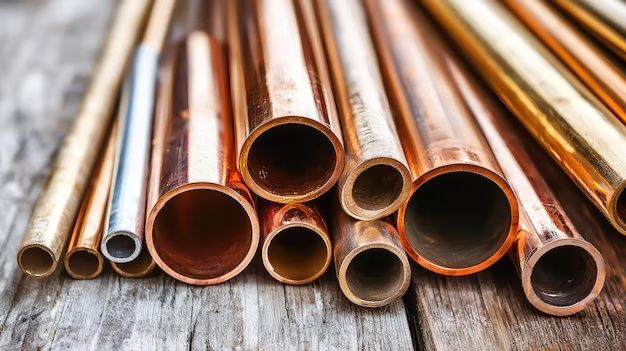Copper is one of the world’s most essential industrial metals. Known for its high conductivity, durability, and recyclability, copper plays a vital role in manufacturing, construction, electronics, renewable energy systems, and telecommunications.
Global demand for copper continues to rise as industries shift toward sustainable infrastructure, electric vehicles (EVs), and green energy solutions. Understanding how copper is manufactured, supplied, and utilized can help businesses and engineers make smarter sourcing decisions.

Importance: Why Copper Is Essential for Modern Manufacturing
Copper is often referred to as the “metal of the future.” Its versatility and electrical performance make it indispensable in industries that power our daily lives.
-
Electrical and Electronics: Used in wiring, circuit boards, transformers, and electric motors due to excellent conductivity.
-
Construction: Found in plumbing, roofing, and heating systems because of corrosion resistance.
-
Transportation: EV batteries, motors, and charging stations depend heavily on copper components.
-
Renewable Energy: Wind turbines, solar panels, and power grids rely on copper cables and coils.
This broad industrial demand drives the global copper supply chain, making it a cornerstone of sustainable and technological progress.
Manufacturing Process of Copper Supplies
The copper production process involves several key stages, from raw ore to refined products ready for industrial use.
1. Mining and Extraction
Copper ore is extracted through open-pit or underground mining. The world’s top producers include Chile, Peru, China, and the United States.
2. Concentration and Smelting
After mining, the ore undergoes crushing, grinding, and flotation to separate copper minerals. The concentrated copper is then smelted and refined to remove impurities.
3. Electrolytic Refining
This process purifies copper to 99.99% purity, ideal for electrical and electronic applications.
4. Fabrication
Refined copper is converted into products such as rods, wires, sheets, and tubes, ready for industrial manufacturing.
Applications: Where Copper Is Used Today
| Industry | Common Applications | Benefits |
|---|---|---|
| Electronics & Electricals | Wires, transformers, circuit boards | High conductivity, reliability |
| Construction | Plumbing, roofing, HVAC | Corrosion resistance, longevity |
| Automotive | EV motors, charging cables | Energy efficiency, recyclability |
| Telecommunications | Data cables, power lines | Strong signal transmission |
| Renewable Energy | Solar and wind systems | Sustainability, high performance |
Copper’s widespread applications make it an irreplaceable material in both traditional industries and emerging technologies.
Recent Updates and Market Insights (2024–2025)
The copper industry is undergoing significant transformation, driven by global sustainability goals and technological innovation.
-
EV Boom: The electric vehicle sector alone could increase copper demand by over 40% by 2030.
-
Smart Grids: Energy-efficient cities and power systems are expanding copper use in high-capacity cables.
-
Recycling Growth: Over 30% of copper used globally now comes from recycled sources, reducing environmental impact.
-
Digital Mining: Use of AI and automation in copper mining improves efficiency and reduces waste.
These trends are positioning copper as a strategic resource for green energy and industrial modernization.
Laws and Environmental Regulations
Copper mining and processing are subject to strict environmental and safety regulations.
-
Waste Management: Smelting and refining plants must follow pollution control standards set by agencies like EPA (US) and EU REACH regulations.
-
Sustainability Mandates: Many countries now require life-cycle assessments (LCA) to track copper’s environmental footprint.
-
Trade and Tariffs: International trade policies influence copper pricing and supply chain dynamics.
Understanding these laws helps manufacturers and importers ensure compliance and sustainable sourcing.
Tools and Resources for Businesses and Engineers
| Tool / Platform | Purpose | Website |
|---|---|---|
| Copper.org | Technical resources and material data | copper.org |
| London Metal Exchange (LME) | Copper price trends and market reports | lme.com |
| USGS Mineral Data | Global production and reserve statistics | usgs.gov |
| Matmatch | Compare material properties for industrial use | matmatch.com |
| MetalMiner | Commodity forecasts and sourcing insights | metalminer.com |
These platforms are essential for manufacturers, suppliers, and investors who track global copper trends.
Challenges in the Copper Supply Chain
-
Price Volatility: Influenced by energy costs, trade tensions, and mining disruptions.
-
Resource Depletion: High-quality ore reserves are declining, increasing reliance on recycling.
-
Environmental Impact: Mining operations face challenges in waste disposal and emissions control.
-
Supply Concentration: Heavy dependence on a few producing countries can affect global stability.
Addressing these issues through innovation and sustainability will define the future of the copper industry.
FAQs: Copper Supplies Explained
Q1. Which countries produce the most copper?
A: Chile, Peru, China, and the U.S. are the leading copper producers globally.
Q2. Is recycled copper as good as new copper?
A: Yes. Recycled copper retains nearly 100% of its original quality and conductivity.
Q3. How is copper priced globally?
A: Prices are set daily on international exchanges like the London Metal Exchange (LME) based on demand and supply.
Q4. What is the lifespan of copper products?
A: Copper can last over 50 years in construction and over 25 years in electrical applications.
Q5. Is copper sustainable?
A: Yes. It’s one of the most recyclable materials, with minimal loss in performance over multiple reuse cycles.
Conclusion
Copper is not just an industrial metal—it’s a foundation of modern infrastructure, clean energy, and digital technology. From manufacturing precision components to powering global renewable systems, copper supplies are vital for sustainable growth.
As industries continue to evolve, efficient copper sourcing, recycling, and innovation will remain central to a smarter and greener future.